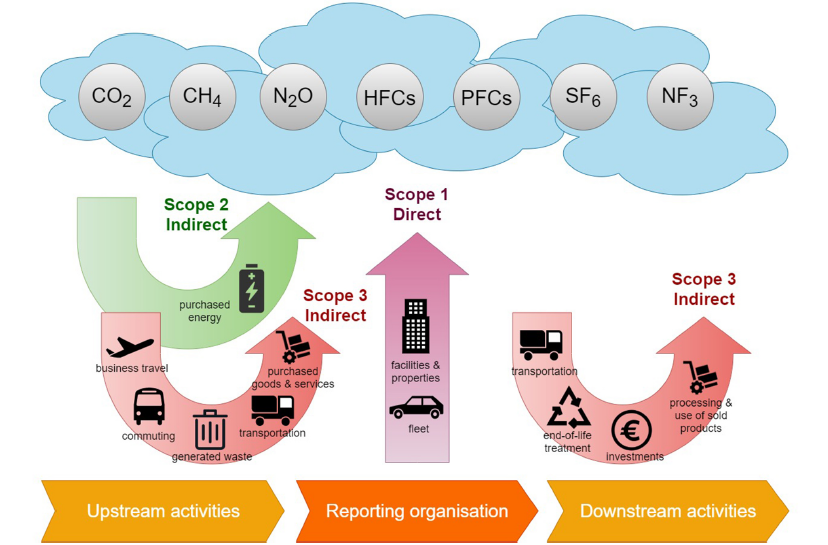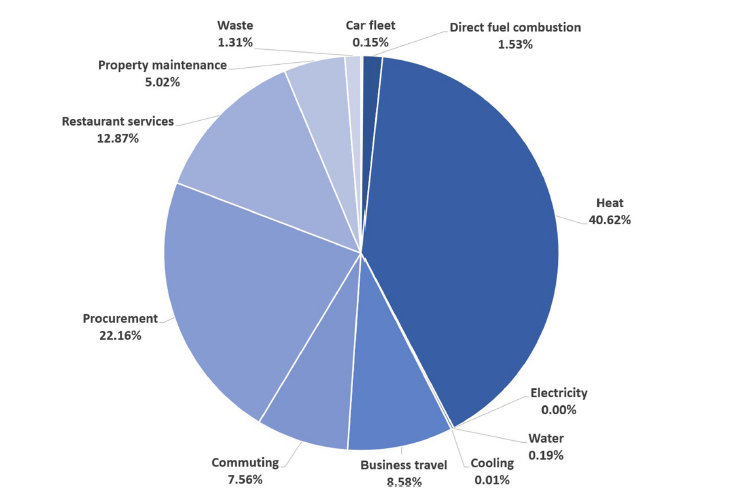Achieving Carbon Neutrality in Higher Education Institutions: The Case of The University of Oulu
CARBON FOOTPRINTLCA


Introduction
Climate change is one of the most pressing problems that the world is facing today. This is already evident based on the events that are unfolding in front of our eyes each day. Europe in the summer of 2023 experienced scorching temperatures in the European countries around the Mediterranean Sea. Greece witnessed a blazing temperature of 46.4 °C in the city of Olympia on the 23rd of July. This was the highest temperature ever recorded in Europe. European countries such as Italy, Spain and Portugal were also in the spotlight of these summer heatwaves.
In light of these problems, Higher Education institutions stand at the front of the fight against climate change. The research publications by university scientists help in identifying problems and solutions to this shared problem. There are several Higher Education Institutions that are committing to becoming carbon neutral by certain dates.
The University of Oulu in Finland is one such institution that has committed to being carbon neutral by 2030. In this blog post, we will explore the challenges and opportunities for achieving carbon neutrality in higher education institutions, as highlighted in a recent research article on the carbon footprint at the University of Oulu.
The Importance of Carbon Neutrality in Higher Education
Higher education institutions play a crucial role in shaping the future by educating and inspiring the next generation of leaders. These institutions create leaders who base their skills and solutions on hard scientific facts and principles.
Carbon neutrality is a state in which an institution's net carbon emissions are reduced to zero. Achieving carbon neutrality involves implementing measures to reduce emissions and offsetting any remaining emissions through activities such as investing in renewable energy projects, carbon capturing, and reforestation projects. In the fight against climate change, several solutions need to be implemented at the same time to ensure the best outcome.
By becoming carbon neutral, higher education institutions will help fight climate change and serve as models for other sectors. This commitment sends a powerful message to students, staff, and the wider community that sustainability is a priority and that everyone has a role to play in mitigating climate change.
The Case of the University of Oulu
The University of Oulu in Finland serves as an inspiring example of a higher education institution committed to achieving carbon neutrality. In this study published by Kiehle et al in 2022, the university outlined its approach to reducing its carbon footprint and shared valuable insights for other institutions. They included a multitude of emissions from Scope 1, Scope 2 and Scope 3 to understand their yearly emissions of GHG. Their main categories for emissions calculations were commuting, heating, electricity and procurement.


Scopes of emissions (retell WRI and WBCSD, 2013)
The research article found that the carbon footprint of the University of Oulu in 2019 was 19,072 t CO2e, with the highest share due to the use of district heat on campus. The study used a hybrid-model approach combining aspects of Life Cycle Assesment and Environmentally Extended Input-Output Analysis to calculate their carbon footprint.


Carbon Footprint of the University of Oulu in 2019 (Kiehle et al., 2022)
As a consequence, the university has implemented various measures to reduce emissions, including energy-efficient building designs, renewable energy installations, and waste management initiatives. They have also invested in research and innovation projects focused on sustainability.
Additionally, the University of Oulu has actively engaged students and staff in sustainability initiatives through awareness campaigns, educational programs, and student-led projects. This engagement has fostered a sense of ownership and collective responsibility for achieving carbon neutrality.
By sharing their experiences and lessons learned, the University of Oulu aims to inspire and guide other higher education institutions on their journey towards carbon neutrality.
Challenges in Achieving Carbon Neutrality
While the goal of carbon neutrality is commendable, it is not without its challenges. According to the University of Oulu's case, the challenges that were present were as follows:
Diverse Work Environment: Achieving carbon neutrality requires a collective effort from all members of the institution. Changing habits and practices is a challenge to implement collectively on the staff, students and community of the institution.
Institution Local Characteristics: The local characteristics of the institution are a major factor in determining the necessary mitigation measures. The environment and operations of the HEI have a significant impact.
Calculation and Assumptions: Calculating the carbon footprint of any institution requires several assumptions and estimations. There are also times when information regarding certain practices is limited which adds more levels of uncertainty when estimating the emissions of an institution.
Opportunities for Achieving Carbon Neutrality
Despite the challenges, there are three main opportunities for higher education institutions to achieve carbon neutrality according to the case study of the University of Oulu:
Collaboration: Collaborating with other institutions, local communities, and industry partners can provide opportunities for sharing knowledge, resources, and best practices. By working together, institutions can leverage collective expertise and accelerate progress towards carbon neutrality.
Technology and Innovation: Advances in technology and innovation offer new possibilities for reducing carbon emissions. When the universities conduct research in innovating sustainable solutions for other sectors such as the industrial sector, they would contribute greatly in reducing the impact of these sectors on GHG emissions.
Role In Sustainability: Integrating sustainability and environmental education into the curriculum can empower students to become agents of change as well as revolutionize the way research is conducted.
Conclusion
Achieving carbon neutrality in higher education institutions is a complex but necessary endeavour. It requires a combination of solving several challenges. These challenges are not without their complexities.
While challenges exist, there are also numerous opportunities for collaboration, technological advancements, and having the university be a beacon of sustainability.
The University of Oulu serves as a shining example of a higher education institution committed to carbon neutrality, providing valuable insights and inspiration for others.
By prioritizing sustainability and taking action to reduce their carbon footprint, higher education institutions can play a vital role in addressing climate change and creating a more sustainable future.
If you want to know more about your carbon footprint, check our user friendly Carbon Footprint Calculator below.
Subscribe to our newsletter


